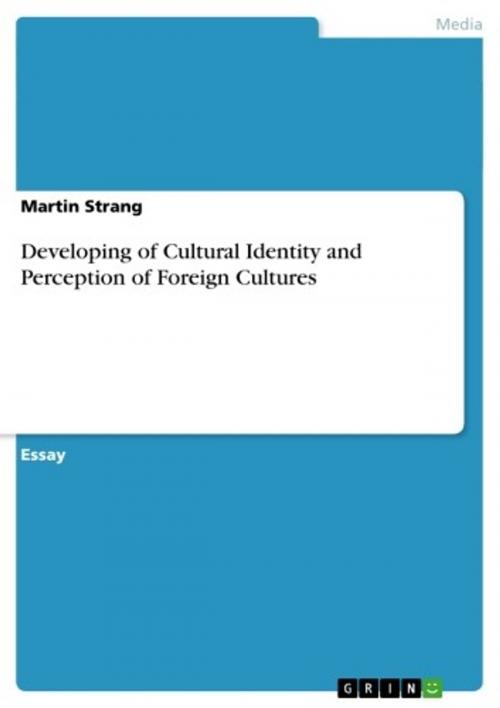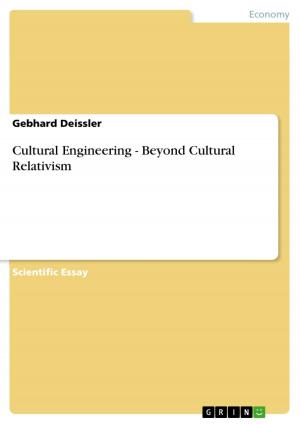Developing of Cultural Identity and Perception of Foreign Cultures
Nonfiction, Reference & Language, Language Arts, Communication| Author: | Martin Strang | ISBN: | 9783638341165 |
| Publisher: | GRIN Publishing | Publication: | January 20, 2005 |
| Imprint: | GRIN Publishing | Language: | English |
| Author: | Martin Strang |
| ISBN: | 9783638341165 |
| Publisher: | GRIN Publishing |
| Publication: | January 20, 2005 |
| Imprint: | GRIN Publishing |
| Language: | English |
Essay from the year 2004 in the subject Communications - Intercultural Communication, grade: High Distinction, Macquarie University (Centre for International Communication), course: Cross Cultural Communication, 9 entries in the bibliography, language: English, abstract: In this critical analysis the question of how people develop their cultural identity and perceive foreign cultures will be answered. This is done through an analysis of the following points: First, different definitions (or attempted definitions) of culture are critically regarded. Then the role of identity in cross-cultural communication is examined, with focus on the creation of cultural identities just as different communication styles related to specific identities. In the third part of this paper the roles of stereotypes in cross-cultural communications are discussed with reference to their functions in society. Finally, the topic of nonverbal communication, especially attempts to describe nonverbal communication of a specific culture, is examined. In the conclusion the results of this paper are discussed and summarised. The essay refers to the movie 'The Quiet American'- in footnotes - to illustrate theoretical aspects with appropriate examples. Culture is a complex and constantly changing phenomenon, so definitions of culture are quite numerous and differing. Brislin (2000, p. 23) refers to the definition of Triandis, Kurowski, Tecktiel & Chan (1993, p. 219), who see culture constructed out of objective and subjective elements. These elements have been selected because in the past they made survival more probable and allowed the participants to exist in ecological niches; they are shared by people who communicate in the same language and live in the same time-place. Even though this definition is obviously general, it cannot be seen as one accepted by all researchers in cross-cultural communication. Brislin (2000, p. 30) tries to define culture by constructing a checklist consisting of twelve points in order to prove if a specific behaviour or ideal is part of one's culture or not. This checklist can be seen as a practical tool for people dealing with cross-cultural settings, but it is hardly a theoretical definition. Raymond Williams (1962, cited in Lull, 1995, p. 130) defines culture as 'a particular way of life', which is shared by a community. The definition of Williams emphasises the dynamic character of culture which changes when we (as members of our own culture) change the way we talk, dress or work. At the same time Williams' definition makes no distinction between 'superior' or 'inferior' cultures, furthermore everybody has their specific 'way of life'.
Essay from the year 2004 in the subject Communications - Intercultural Communication, grade: High Distinction, Macquarie University (Centre for International Communication), course: Cross Cultural Communication, 9 entries in the bibliography, language: English, abstract: In this critical analysis the question of how people develop their cultural identity and perceive foreign cultures will be answered. This is done through an analysis of the following points: First, different definitions (or attempted definitions) of culture are critically regarded. Then the role of identity in cross-cultural communication is examined, with focus on the creation of cultural identities just as different communication styles related to specific identities. In the third part of this paper the roles of stereotypes in cross-cultural communications are discussed with reference to their functions in society. Finally, the topic of nonverbal communication, especially attempts to describe nonverbal communication of a specific culture, is examined. In the conclusion the results of this paper are discussed and summarised. The essay refers to the movie 'The Quiet American'- in footnotes - to illustrate theoretical aspects with appropriate examples. Culture is a complex and constantly changing phenomenon, so definitions of culture are quite numerous and differing. Brislin (2000, p. 23) refers to the definition of Triandis, Kurowski, Tecktiel & Chan (1993, p. 219), who see culture constructed out of objective and subjective elements. These elements have been selected because in the past they made survival more probable and allowed the participants to exist in ecological niches; they are shared by people who communicate in the same language and live in the same time-place. Even though this definition is obviously general, it cannot be seen as one accepted by all researchers in cross-cultural communication. Brislin (2000, p. 30) tries to define culture by constructing a checklist consisting of twelve points in order to prove if a specific behaviour or ideal is part of one's culture or not. This checklist can be seen as a practical tool for people dealing with cross-cultural settings, but it is hardly a theoretical definition. Raymond Williams (1962, cited in Lull, 1995, p. 130) defines culture as 'a particular way of life', which is shared by a community. The definition of Williams emphasises the dynamic character of culture which changes when we (as members of our own culture) change the way we talk, dress or work. At the same time Williams' definition makes no distinction between 'superior' or 'inferior' cultures, furthermore everybody has their specific 'way of life'.















